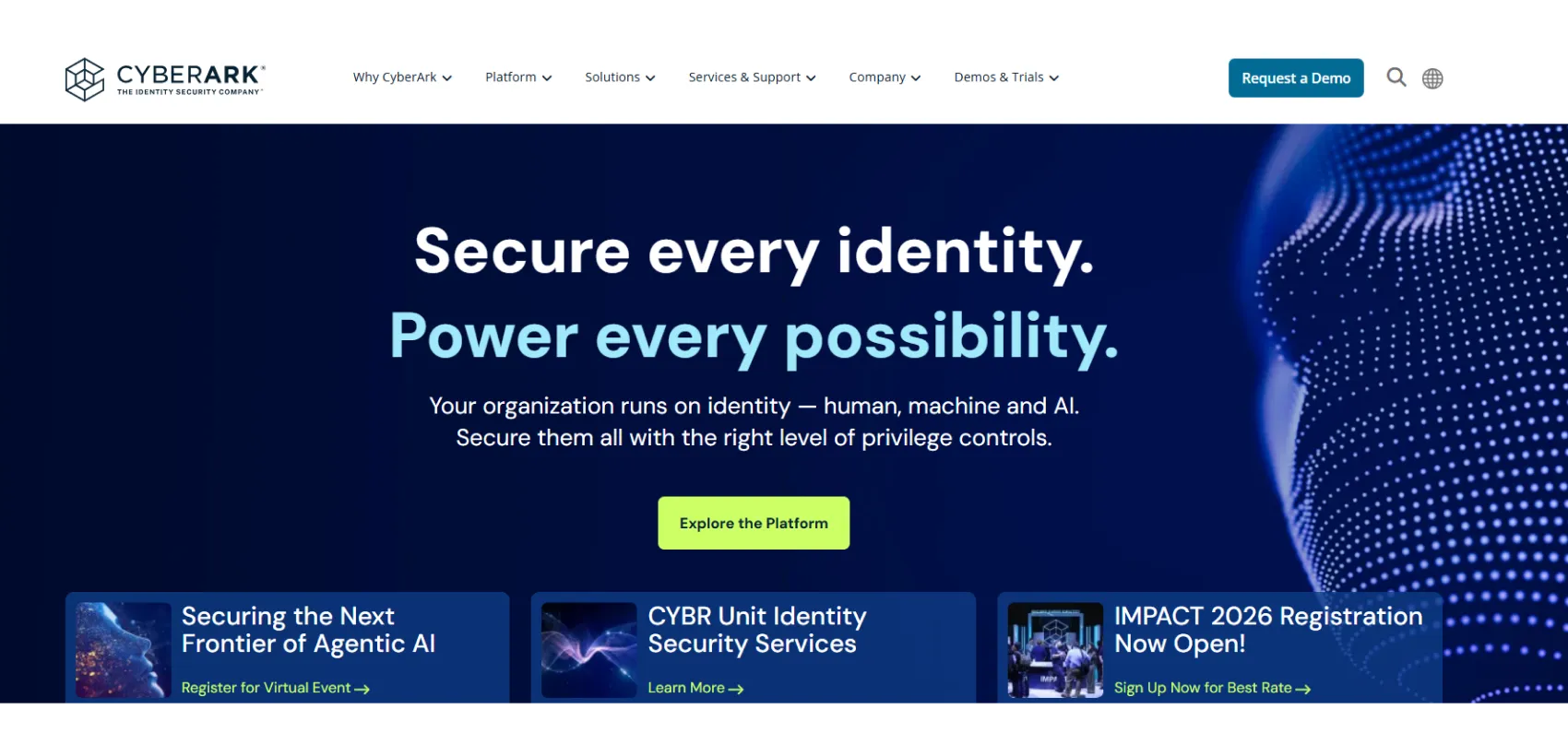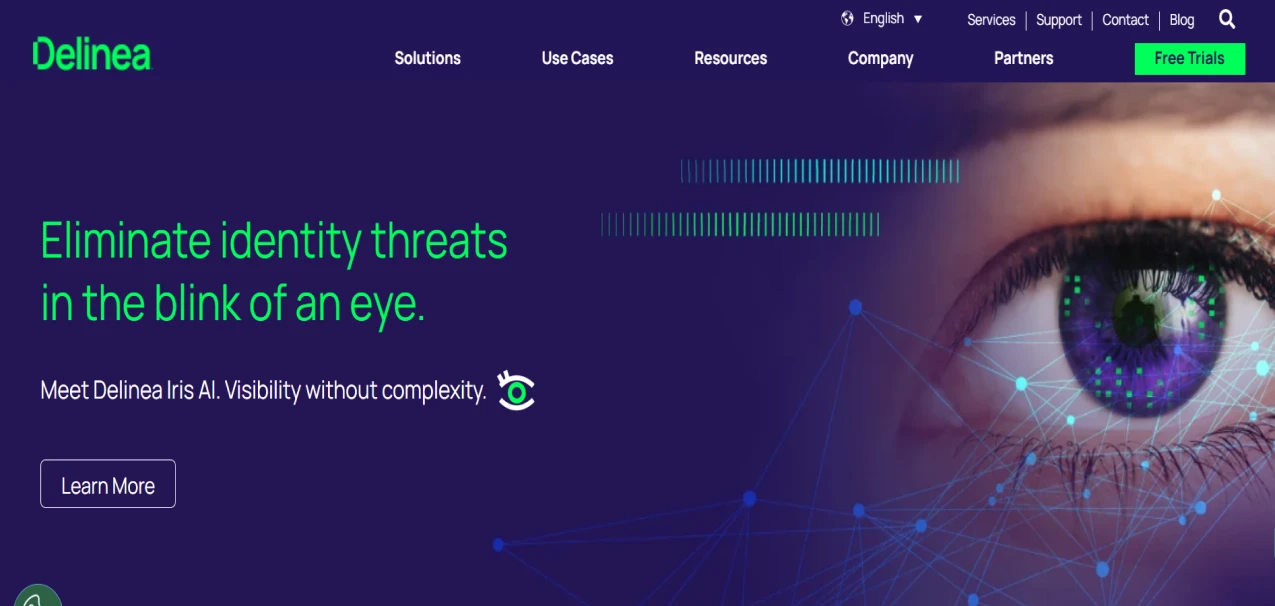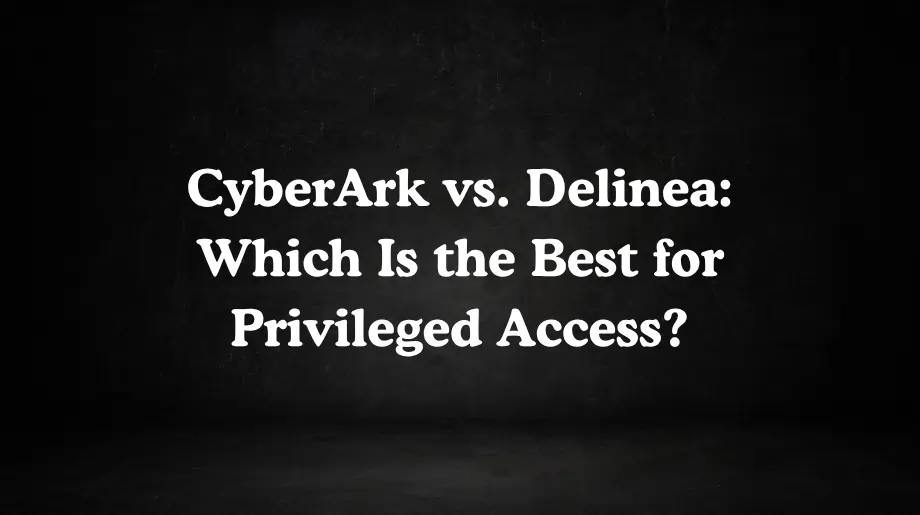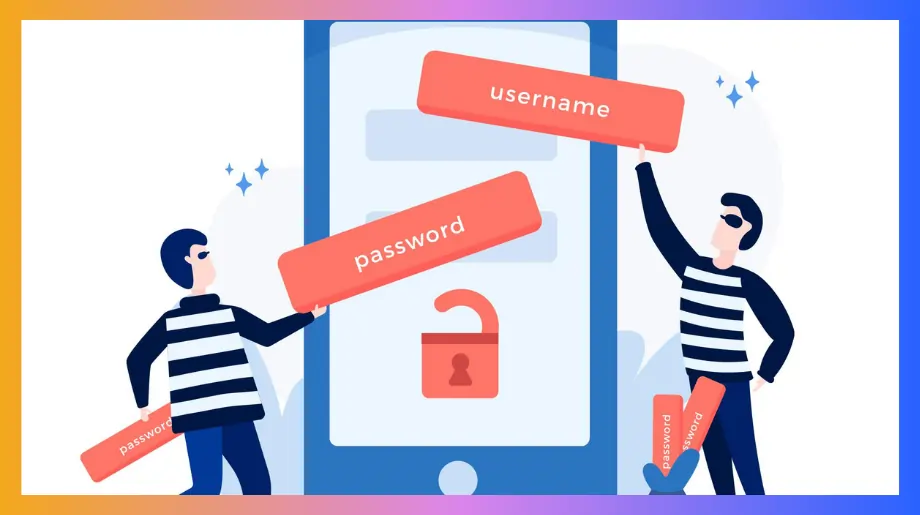Privileged access can decide the future of your business. One stolen admin login can put customer data at risk. Systems can stop working. Fines can arrive fast. That is why choosing the right tool matters so much.
When it comes to Delinea vs CyberArk the real question is simple. Do you want the most powerful set of security features or a platform that is quick and easy for people to use every day?
CyberArk is built for deep enterprise protection. Delinea is built for speed and simplicity. To see how identity and access management protects against real threats check out this guide and find the option that feels right for your business.
CyberArk vs. Delinea: A Detailed Comparison
What is CyberArk?
CyberArk is made for large companies that face big security risks. Many Fortune 500 firms already use it and the company keeps improving it every year with huge investments.

The main job of CyberArk is to protect accounts that have admin power. It watches them, it manages them and it keeps them safe across both cloud and on-prem systems. It also blocks hackers who try to turn normal accounts into admin accounts on laptops or servers.
Another part of CyberArk is the digital vault. This is where all admin passwords and keys stay safe with very strong protection. On top of that you get session tracking tools that spot threats and reports that help with compliance.
So when a business has many systems and needs serious security CyberArk gives full control and strong protection in one place through comprehensive enterprise access management solutions.
What is Delinea?
Delinea started in 2021 when Thycotic and Centrify joined. It was made to solve modern privileged access problems without too much complexity. Many companies pick it because it is faster to set up, easier to use, and simpler than CyberArk.

The platform has three main parts.
- Secret Server protects passwords and keys.
- Privileged Remote Access gives admins a safe way to connect.
- Server PAM adds protection for Unix and Linux systems. These parts cover the most important needs without heavy extras.
Delinea focuses on speed and ease. The interface is simple, the license model is clear, and setup is quick. This helps companies get value faster, reduce admin work, and still stay secure through effective privileged access management.
It is often chosen by mid-sized firms and large enterprises that want strong security with less cost and less effort.
Difference Between CyberArk vs. Delinea (2025 Edition)
When a company picks a privileged access tool it must think beyond just storing passwords. Each tool fits different company sizes, tech setups, and ways of working. We will compare CyberArk vs Delinea on the key points that matter. This will help you see which one really works for your business.
Key Features of CyberArk vs. Delinea
CyberArk Core Capabilities
- Digital Vault Architecture. The vault keeps all passwords and keys safe. It uses strong encryption and can work with hardware security modules. It can run in high-availability mode and switch over automatically if needed. Everything is stored in one place and access is tracked carefully.
- Privileged Session Management. CyberArk records and monitors sessions when admins use important systems. It analyzes patterns in real time and can end sessions if something seems risky or against policy.
- Endpoint Privilege Manager. This tool controls apps and admin rights on Windows and Unix. It removes unnecessary local admin rights but still lets people do their work. It also detects malware and attacks on endpoints.
- Secrets Manager. This manages passwords and keys for DevOps and cloud apps. Secrets can change automatically and access can be given only when needed. It works with CI/CD pipelines and container systems.
Delinea Core Capabilities
- Secret Server. This is a central vault that keeps all passwords and keys safe. It finds passwords automatically and can change them on schedule. Access is controlled with roles and approvals for sensitive accounts. It works with your existing directories and identity systems through identity and access management software.
- Privileged Remote Access. Admins can connect to servers and apps through a browser without using a VPN. All sessions are recorded and logged for audits. It works with RDP, SSH, and web applications.
- Server PAM. This manages admin rights on Unix and Linux systems. Sudo commands are logged and accounts are controlled throughout their lifecycle. It integrates with existing Unix authentication systems.
- Cloud PAM. It protects privileged access in cloud systems like AWS, Azure, and Google Cloud. Credentials rotate automatically. The platform works smoothly with cloud identity and access management tools.
Integration with Existing Infrastructure
CyberArk Infrastructure Integration
- Enterprise Directory Services. CyberArk works with Active Directory, LDAP, and other identity systems. Users and roles get added and updated automatically. Admins can log in once and access everything with single sign-on.
- SIEM and Security Tools. It links with security monitoring tools to give a full picture. Threat info is shared with automation tools. You can also connect your own security systems easily.
- Database and Application Security. CyberArk connects directly to databases and helps apps log in to each other safely. You can use SDKs to build extra custom connections.
Delinea Infrastructure Integration
- Simplified Directory Integration. Delinea works with Active Directory and keeps it updated with very little setup. It also works with LDAP for mixed systems. You can use normal login methods without any complex setup.
- Popular Business Applications. It comes with pre-built connectors for common apps and cloud services. You can also use APIs to connect other apps. Everything works with standard protocols so setup is easy.
- Cloud Platform Integration. Delinea connects to big cloud providers using standard APIs. It can find cloud resources and privileged accounts automatically. It works in hybrid clouds and keeps policies the same everywhere through cloud-based identity and access management.
Privileged Access & Security Compliance
CyberArk Security & Compliance
- Zero Trust Architecture. CyberArk gives users only the access they need and checks it all the time through zero trust principles. It uses analytics and machine learning to find threats. Policies can be adjusted automatically based on risk or user activity.
- Regulatory Compliance. It generates reports for regulations such as SOX, PCI DSS, HIPAA, and other compliance standards. Audit logs are automatic and cannot be changed. The dashboard shows any policy violations as they happen.
- Threat Detection & Response. CyberArk looks for unusual activity using analytics and machine learning. It connects to threat intelligence feeds to stay ahead of problems. It can also respond automatically to risky actions or rule violations.
Delinea Security & Compliance
- Essential Security Controls. Delinea lets you control who can do what with roles and approvals using advanced authentication methods. Important actions need approval. Sessions are recorded for audits and compliance. It does not have all the advanced analytics of CyberArk, but it gives most companies what they really need without extra confusion.
- Streamlined Compliance. It makes basic compliance reports for common rules. Audit logs are easy to search and export. You get templates for standard policies and frameworks.
- Risk Management. Password rules are enforced with rotation and complexity. Simple analytics help spot risks and rule breaks. It also works with vulnerability tools to prioritize what is most important.
Customization & Flexibility
CyberArk Customization
- Extensive API Framework. CyberArk gives REST APIs for custom development and connecting other tools. SDKs work with many programming languages. You can also use scripts for complex automation and workflows.
- Policy Engine. The platform has a strong policy system with rules that can change based on conditions using attribute-based access control. You can build custom workflows for approvals and access. Reports and dashboards can also be customized to fit your needs.
- Platform Extensions. There is a marketplace with third-party extensions and connectors for special needs. Professional services are available for more complex projects. The community also shares tools and solutions for common situations.
Delinea Customization
- User-Friendly Configuration. Delinea has a web interface that is easy to use. Setup templates help with common scenarios. You do not need much technical skill to configure and maintain it.
- Standard Integration Options. It provides REST APIs for common integrations and development. PowerShell can be used for Windows automation and scripting. There is a standard library of connectors for popular business apps and systems.
- Deployment Flexibility. You can deploy on-premises, in the cloud, or in hybrid setups. Moving between deployment types is easy without much rework. Licensing is simple and grows with your company needs.
Lifecycle Automation & Governance
CyberArk Automation & Governance
- Advanced Workflow Engine. CyberArk lets you set up approval steps with many stages and escalation rules. It connects with HR systems to add or remove users automatically through user lifecycle management. Routine admin tasks can run automatically using policies.
- Identity Governance. You can check who has access to privileged accounts and approve or fix it through identity governance and administration. Rules can catch problems automatically and workflows can handle fixes. It also works with other identity tools so access is controlled in one place.
- DevOps Integration. CyberArk works with CI/CD pipelines to keep credentials safe during development. Secrets are given only when needed for containers and microservices. The platform is made for modern development and deployment.
Delinea Automation & Governance
- Simple Workflow Engine. In this Delinea vs CyberArk comparison, Delinea lets you create approval steps that are easy to follow. Important tasks can require approvals before they happen. It can also connect with HR systems to add or remove users automatically.
- Identity Governance. You can check who has access and make sure it is correct. Rules can catch problems automatically and fix them through identity governance solutions. It works with other identity tools to keep everything under control in one place.
- DevOps Support. Delinea can manage passwords and keys safely for development workflows. Secrets can be given only when needed. It works well with modern cloud and container applications.
Pricing & Support
CyberArk Pricing & Support
When comparing CyberArk pricing, CyberArk is a high-end solution, so it can cost a lot. Companies often spend around 30,000 dollars. If you run it on your own servers, you may need to pay more for services, infrastructure, staff, and premium support. This can add 30 to 70 percent on top of the license.
- Enterprise Licensing. The price depends on what you need, how many users, and how you deploy it. You usually need professional help for setup and configuration. Premium support gives you dedicated managers and technical help when you need it.
- Implementation Services. CyberArk has certified consultants who guide setup and deployment. Complex projects can take months to over a year. They also help with upgrades, optimization, and using advanced features over time.
Delinea Pricing & Support
When looking at Delinea pricing, it has simple pricing. You pay per user, and costs are easy to predict. There are a few hidden fees. Customers give it high ratings.
- Rapid Deployment. Setting up Delinea usually takes weeks instead of months. You can use guided setup wizards to do it yourself. Professional services are available if you need them but most standard setups do not require them.
- Standard Support. Your license includes support for setup and technical issues. It ensures user provisioning and deprovisioning is done correctly. You also get access to guides, training and forums. Professional services help with complex needs.
Use Cases of CyberArk and Delinea
CyberArk Optimal Use Cases
- Large Enterprise Environments. CyberArk is best for very big companies with many admin accounts. It can manage multiple data centers, cloud services, and old systems together. It also helps follow rules with strong audits and controls.
- High-Security Industries. It works well for banks, government, and critical infrastructure. These industries face big security risks and need advanced tools to find threats. They also have dedicated security teams and many security systems.
- Complex Integration Requirements. CyberArk fits places with many custom apps, special systems, and security tools. It works well for teams that need full secrets management and automation using APIs.
Delinea Ideal Use Cases
- Mid-Market Organizations. Delinea is good for medium companies that need full privileged access management without enterprise complexity or high costs. It works for simple IT environments and standard business apps.
- Rapid Deployment Requirements. It is ideal when you need a solution fast. Setup is quick and simple. Companies with small security teams can manage it easily with intuitive tools.
- Cost-Sensitive Environments. Delinea fits companies that need essential privileged access management without paying for extra premium features through best PAM solutions. Licensing is predictable and ongoing services are low.
Limitations and Challenges of Delinea vs CyberArk
CyberArk Limitations
- Implementation Complexity. CyberArk can be hard to set up. You often need professional help for deployment. Admins need special training and ongoing learning. The architecture is complex and needs dedicated technical staff to keep it running.
- High Total Cost of Ownership. The license costs a lot upfront. Professional services and setup are required. You also pay for support, upgrades, and new features. Extra costs may come from infrastructure, special staff, and integrations.
- Feature Overwhelming. CyberArk has many features that can confuse companies with simple needs. Policy setup can be complex. Smaller teams may find it over-engineered for basic PAM requirements.
Delinea Limitations
- Limited Advanced Features. In the CyberArk and Delinea difference, Delinea does not have all the advanced session recording or analytics of CyberArk. But it gives most companies exactly what they need for managing privileged accounts without unnecessary complexity.
- Scalability Constraints. It may not work well for very large companies with thousands of users. Customization is limited for unique workflows or integrations. Performance may be affected in high-transaction environments with lots of automation.
- Market Position. CyberArk is ranked number one with a strong mindshare and product ecosystem. Delinea has a smaller presence and fewer market resources. This could affect long-term roadmap and ecosystem support.
Infisign: A Modern Alternative to CyberArk and Delinea
Infisign changes how companies handle privileged access and identity security.
The IAM Suite manages workforce identities for employees and internal teams. It handles logins for staff members and controls who can access what inside your organization. UniFed takes care of customer identity and access management. It manages how your customers log in to your apps and platforms. Together these two platforms make security both strong and practical.
Passwordless Authentication.
- Infisign's passwordless authentication eliminates the biggest security weakness in your infrastructure.
- The system supports FIDO2 for hardware security keys, WebAuthn for browser-based logins, passkeys for seamless device authentication and magic links sent directly to verified email addresses.
- Your team picks what works best for their workflow. Users log in with biometrics, passkeys or secure links.
Secure Password Vault with ZKP Architecture.
- The built-in password vault uses Zero-Knowledge Proof architecture. This means Infisign itself cannot access your stored credentials. Only you hold the encryption keys.
- Passwords are encrypted on your device before they ever leave it. They sync across your devices without ever exposing plaintext data to any server. Even if someone breaks into Infisign's infrastructure they get nothing usable.
- Traditional vaults from CyberArk and Delinea store encrypted passwords on their servers which creates a single point of failure. Infisign eliminates that risk completely.
Universal Single Sign On.
- Infisign's SSO deploys in just 4 hours. Pre-built connectors for over 6000 applications mean your team starts working the same day you decide to implement it.
- The system uses standard protocols like SAML and OAuth so even custom apps integrate without custom development work. Users log in once. Integration is fast. Teams stay productive. An employee clicks their email once in the morning and accesses every tool they need without typing another password all day.
Infisign’s Adaptive MFA.
- Fingerprints, one-time codes, push approvals and face recognition all work together through Infisign’s multi-factor authentication that adjusts based on real-time risk assessment.
- Normal logins from trusted devices need just one factor. Unusual activity triggers additional verification layers.
Privileged Access Management Built for Modern Teams.
- Infisign's PAM solution manages privileged accounts with time-bound access, just-in-time elevation and automatic session recording. Sensitive roles get time-bound access through least privilege access.
- Admin privileges are granted only when someone needs them for a specific task. A database administrator requests elevated access to fix a production issue. The system grants it for exactly 2 hours then revokes everything automatically. No account has unchecked power.
- All actions are monitored and recorded. Every command typed during elevated sessions gets logged for compliance and security review. Elevated rights expire automatically. Insider risks drop. Governance stays simple.
Non-Human Identity Management.
- APIs, service accounts, bots and automated workflows need secure access just like humans do. Infisign manages non-human identities with the same security controls you use for employees.
- Your CI/CD pipeline needs database credentials to run tests. The system provides temporary credentials that work only during the test run then expire automatically.
- Machine-to-machine authentication happens through short-lived tokens instead of hardcoded passwords sitting in config files. Integrates with CRMs, ERPs, cloud apps and legacy systems through non-human identities.
- Credentials rotate automatically without breaking your automation. Access is scoped precisely so each service account can only touch what it absolutely needs. Every machine-to-machine interaction gets logged for audit trails.
Managed Password Web Authentication for Legacy Apps.
Infisign's MPWA securely manages credentials for legacy web applications that lack modern SSO support. Passwords stay encrypted in vaults and auto-fill into login forms without user interaction. Automated rotation happens on schedule without breaking access. Users never see or type sensitive credentials manually.
Network Access Gateway for Secure Remote Access.
Infisign's Network Access Gateway extends Zero Trust controls to on-premises systems. Remote teams access internal databases through encrypted TLS tunnels. Role-based policies control who reaches which resources. Third-party vendors get temporary access without touching your internal network directly.
AI Access Assist for Intelligent Provisioning.
Infisign's AI Access Assist automates access decisions by analyzing user behavior and roles in real-time. Developers request database access through Slackand Teams; AI grants time-bound permissions instantly. Manual approvals disappear for routine requests. Security teams focus on real threats while AI handles provisioning, flagging anomalies automatically.
Seamless Integrations Across Your Entire Tech Stack.
- Infisign connects with your existing infrastructure through over 6000 pre-built APIs and SDKs. Active Directory syncs in minutes. Okta, AWS, Google Workspace and Slack all work out of the box.
- REST APIs and comprehensive SDKs let you build custom connections when you need something unique. Everything works together without forcing you to replace systems that already work.
Decentralized Identity and Reusable Credentials.
- Users control their own identity data instead of companies hoarding it. Information gets shared only when absolutely necessary and only with explicit user consent. You prove your identity once using verified credentials stored on your device.
- Different services verify those credentials without storing copies of your personal information. Credentials work across multiple platforms without forcing users to recreate profiles everywhere. Privacy, speed and trust all improve simultaneously.
Automated Lifecycle Management.
- Hiring, role changes or exits automatically update access. Rajni joins as a marketing manager on Monday. The system creates her accounts, assigns her to the right groups and provides access to Salesforce, HubSpot and Google Workspace before she sits down at her desk.
- HR and directories stay in sync. She switches to sales in July. Marketing access disappears and sales tools appear without IT touching anything. Permissions adjust themselves. She leaves in December. Every account closes, every session ends and every credential expires within minutes of HR marking her as terminated. Manual work disappears. Access creep stops. No forgotten accounts. No orphaned permissions. No manual cleanup required.
Identity Governance and Administration.
- Infisign's identity governance eliminates manual audit work that wastes weeks every quarter. Automated reviews catch orphaned accounts and excessive privileges before they become security risks.
- AI-powered certifications reduce compliance violations by flagging suspicious access patterns instantly. Managers approve or revoke access in minutes instead of drowning in spreadsheets.
- Policy-driven provisioning stops access creep completely while ensuring audit trails satisfy regulators without extra effort.
Attribute-Based Access Control.
- ABAC dramatically reduces data breach risk by enforcing context-aware access decisions automatically.
- Insider threats get neutralized because access depends on location, time, device health and role combined.
- Legitimate users stay productive because the system never blocks normal work patterns. You eliminate standing privileges without creating approval bottlenecks or complex permission matrices.
- Granular control protects sensitive data while keeping workflows smooth for employees, contractors and partners.
Compliance and Governance.
- GDPR, HIPAA, SOX and CCPA requirements are built directly into the platform. Pre-built compliance templates for major regulations mean you're audit-ready from day one.
- Every login, every permission change, every elevated session gets recorded in tamper-proof audit trails. Reports are ready instantly. AI handles access certifications and compliance reviews in hours instead of weeks.
24 by 7 Security Monitoring.
- Activity tracking runs continuously without human intervention.
- AI analyzes patterns across millions of authentication events to spot threats that humans would miss.
- Unusual login patterns, suspicious permission changes, abnormal data access and risky behavior get flagged instantly. Automated playbooks respond to routine threats without waking up your security team.
- A bot tries to brute-force accounts. The system blocks it, logs everything and sends a summary report. Critical alerts about genuine threats go straight to your security team with full context and recommended actions. Logs and compliance reports stay ready 24/7 for instant access.
When comparing Delinea vs cyberark most companies face an impossible choice. CyberArk delivers enterprise power but demands months of implementation pain and massive upfront investment. Delinea offers simplicity but lacks advanced features for complex environments. Infisign breaks that compromise completely. You get enterprise-grade security that deploys faster than either competitor. Your security team gains the control and visibility they need. Your users enjoy seamless access through biometric authentication and cutting-edge passwordless methods.
Book your demo and experience how privileged access management should work in 2025. No aggressive sales tactics. No lengthy procurement process.
FAQs
What are the cons of Delinea?
Delinea is easy to use and simple to set up. It lacks advanced session recording and analytics capabilities. It may not work well for huge companies. Customization is limited. Companies with high security needs may require more comprehensive enterprise solutions.
What are the best CyberArk Alternatives?
Good CyberArk alternatives are Infisign for passwordless access. BeyondTrust for full privileged access management. Delinea for simple setup. Hashicorp Vault for secrets management. StrongDM for developer friendly zero trust access. Each option works for different company sizes and needs.
What are the best Delinea Alternatives?
Top Delinea alternatives are Infisign for next generation passwordless PAM. CyberArk for full enterprise security. BeyondTrust for unified PAM and remote access. Keeper Security for passwords with PAM. ManageEngine PAM360 for budget friendly setups. Pick what matches your size and needs.
Are Okta and CyberArk the same?
No. Okta and CyberArk are different. Okta manages normal user access with single sign on and multi factor authentication. CyberArk protects privileged accounts and critical systems. Okta handles daily users. CyberArk secures admin and high risk credentials.






















